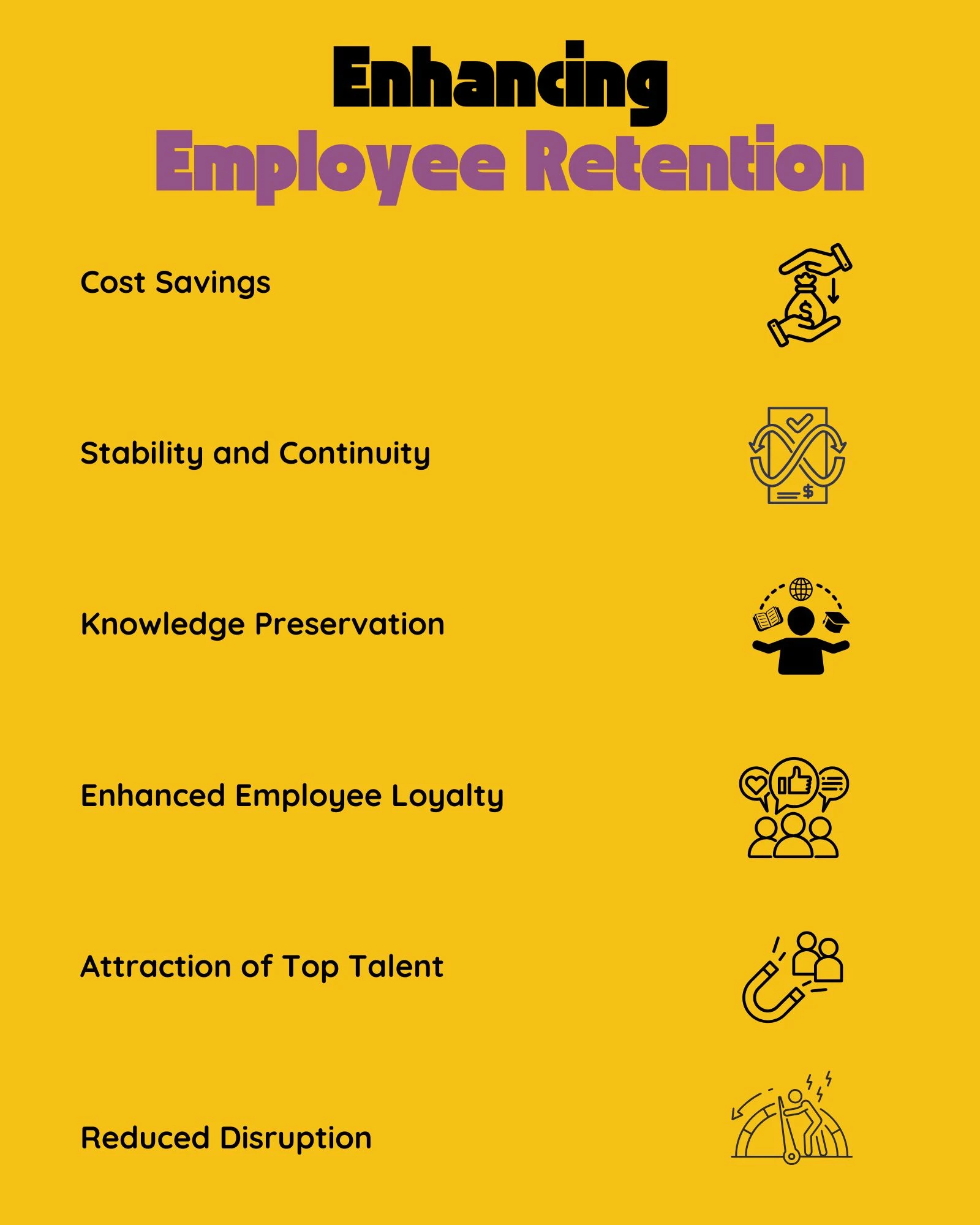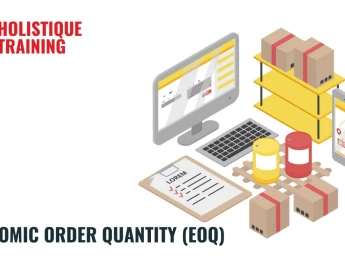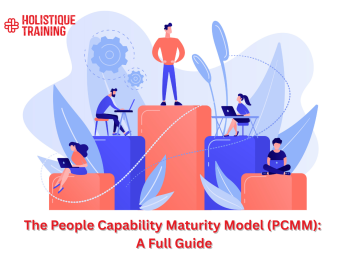- Table of Contents
- Introduction
- Employee Engagement Strategies
- Regular Communication
- Recognition Programmes
- Skill Development Opportunities
- Work-Life Balance Initiatives
- Positive Company Culture
- The Significance of Employee Retention
- Cost Savings
- Positive Work Environment
- Knowledge and Expertise
- Reputation Building
- Employee Engagement and Commitment
- Enhancing Employee Retention
- Cost Savings
- Stability and Continuity
- Knowledge Preservation
- Enhanced Employee Loyalty
- Attraction of Top Talent
- Reduced Disruption
- How to Increase Your Employee Retention Rate
- Crafting a Successful Employee Engagement and Retention Strategy
- 1. Hiring the Right People:
- 2. Regular Communication, Feedback, and Recognition:
- 3. Opportunities for Growth and Development:
- 4. Work-Life Balance Initiatives:
- 5. Positive Work Environment:
- 6. Leadership Commitment:
- The Future of Employee Engagement
- Embracing Technology
- Flexibility and Personalisation
- Data Analytics and Artificial Intelligence
- Continuous Learning and Development
- Employee Well-being
- Agility and Adaptability
- Lifelong Engagement
- Learning Resources
- The Link Between Employee Engagement and Staff Retention
- Engagement Boosts Retention:
- Staff Retention Enhances Engagement:
- Commitment Drives Loyalty:
- Positive Feedback Loop:
- Organisational Benefits:
- Conclusion
Introduction
In today's competitive business landscape, the success of any organisation hinges on its ability to engage and retain its employees. Engaged employees bring commitment, motivation, and a willingness to go the extra mile to the workplace while maintaining valuable talent. This helps save costs related to employee turnover and ensures long-term stability. In this comprehensive article, we will delve deep into the world of employee engagement and retention, exploring strategies to boost both their importance and what the future holds for these critical aspects of organisational success.
Employee Engagement Strategies
Employee engagement is a multifaceted concept, and organisations employ various strategies to foster a sense of dedication and enthusiasm among their workforce. Here, we delve deeper into these strategies to understand how they contribute to a vibrant and engaged workplace:
Regular Communication
Effective communication is the lifeblood of any organisation. It involves conveying information and creating a transparent and two-way flow of dialogue. Regular communication ensures that employees know the company's goals, changes, and expectations well. This strategy also encourages employees to voice their opinions, ask questions, and share feedback. It promotes a sense of belonging and helps employees understand their role in the bigger picture.
Recognition Programmes
Recognising and appreciating employees' efforts and achievements is a powerful tool in boosting morale and motivation. Recognition can take various forms, from simple verbal praise to formal awards and bonuses. When employees feel their hard work is acknowledged and valued, it reinforces their commitment to the organisation. Moreover, a well-designed recognition programme can contribute to a positive work culture where excellence is celebrated.
Strategy | Description |
Regular Communication | Ensure open channels for company-employee dialogue. |
Recognition Programmes | Acknowledge and reward employee contributions. |
Skill Development Opportunities | Provide avenues for continuous skill enhancement. |
Work-Life Balance Initiatives | Support employee well-being and work-life balance. |
Positive Company Culture | Foster an inclusive, supportive work environment. |
Table 1: Employee Engagement Strategies
Skill Development Opportunities
In today's rapidly evolving work landscape, employees value opportunities for skill development and growth. Providing avenues for employees to enhance their skills benefits them personally and contributes to the organisation's growth. Skill development opportunities can include workshops, courses, mentorship programmes, and access to online learning resources. By investing in their employees' professional growth, organisations nurture engagement and equip their workforce to meet new challenges.
Work-Life Balance Initiatives
Balancing work and personal life is crucial for employee well-being. Work-life balance initiatives are designed to support employees in managing their professional responsibilities while maintaining a healthy personal life. This can involve offering flexible work hours, remote work options, generous vacation policies, and wellness programmes. When employees can attend to personal matters and recharge, they are likelier to remain engaged and productive at work.
Positive Company Culture
A positive company culture is the foundation of employee engagement. It encompasses values, behaviours, and norms that define the workplace atmosphere. Organisations prioritising a healthy work culture often see increased job satisfaction and employee engagement levels. This includes promoting teamwork, collaboration, diversity, inclusivity, and a sense of belonging. A positive culture fosters an environment where employees feel supported, respected, and motivated to contribute their best.
Each of these strategies contributes to building a holistic approach to employee engagement. While they can be implemented individually, their effectiveness is often amplified when integrated into a comprehensive engagement strategy. By focusing on regular communication, recognition, skill development, work-life balance, and positive company culture, organisations can create an environment where employees are committed and enthusiastic about their roles and the organisation's success.
The Significance of Employee Retention
Employee retention is a metric that goes beyond the numbers; it reflects the heart and soul of an organisation. High employee retention rates indicate a thriving and stable work environment where employees feel valued, engaged, and committed to their roles and the organisation's mission. Let's explore the multifaceted significance of employee retention:

Cost Savings
Cost savings is one of the most tangible benefits of high employee retention rates. Recruiting, onboarding, and training new employees can be resource-intensive and expensive. Employees leaving the organisation incur direct costs regarding recruitment advertising, interview expenses, and training materials. Moreover, indirect costs are associated with decreased productivity during the learning curve of new hires. Retaining experienced employees helps organisations save these substantial financial resources, which can be reinvested in other critical business areas.
Positive Work Environment
High employee retention contributes to a positive work environment. Employees seeing their colleagues staying with the organisation over the long term fosters a sense of stability and continuity. A stable workforce leads to increased morale, as employees feel confident in their positions and are more likely to invest in building strong working relationships. This, in turn, contributes to a more harmonious and productive workplace.
Knowledge and Expertise
Long-term employees often possess a wealth of institutional knowledge, skills, and expertise. They deeply understand the company's processes, culture, and history. This reservoir of knowledge is invaluable for an organisation's growth and innovation. When employees remain with the company, they can leverage this knowledge to drive improvements, offer mentorship to newer team members, and participate actively in problem-solving and decision-making processes. In essence, they become indispensable assets to the organisation.
Reputation Building
High retention rates enhance the company's reputation, both as an employer and in the market. An employer's reputation for retaining talent makes the organisation an attractive destination for top candidates. This can significantly ease recruitment as prospective employees are drawn to companies with a track record of valuing and retaining their staff. Furthermore, in the market, a company with a stable and experienced workforce is often viewed as reliable and trustworthy, which can positively impact its relationships with clients, customers, and partners.
Employee Engagement and Commitment
A key driver of employee retention is the level of engagement and commitment employees feel toward their work and the organisation. Engaged employees are likelier to stay with an organisation because they find meaning, satisfaction, and fulfilment in their roles. They develop a sense of purpose and connection to the company's mission and vision. When employees feel that their contributions are valued and they have opportunities for growth and development, their commitment to the organisation deepens. High retention rates, therefore, reflect a committed and dedicated workforce.
In summary, employee retention is not just about keeping employees from leaving; it's about nurturing an environment where employees thrive and flourish. The significance of employee retention extends far beyond the retention rate itself; it encompasses financial savings, a positive workplace culture, knowledge retention, a strong reputation, and the embodiment of employee engagement and commitment. By prioritising strategies that enhance retention, organisations lay the foundation for long-term success and sustainable growth.
Enhancing Employee Retention
Employee retention is not merely a matter of keeping individuals within an organisation; it represents a strategic imperative with far-reaching implications for an organisation's stability and growth. Let's explore in greater detail why enhancing employee retention is paramount:
Cost Savings
Cost savings is one of the most immediate and practical benefits of enhancing employee retention. Employee turnover can be an expensive proposition. Recruiting, onboarding, and training new hires is resource-intensive and financially burdensome. Furthermore, the organisation incurs indirect costs related to decreased productivity during the transition period of new employees. Organisations can minimise these financial burdens and allocate resources more efficiently by actively working to retain staff.
Stability and Continuity
Enhancing employee retention contributes to the establishment of a stable and continuous workforce. When employees remain with the organisation over the long term, it fosters a sense of stability that permeates the workplace. Team members build stronger working relationships, honing their collective effectiveness. This sense of continuity allows organisations to execute long-term strategies confidently, knowing they have a deeply familiar team with the company's operations and goals.
Knowledge Preservation
Long-serving employees are custodians of institutional knowledge. They deeply understand the organisation's history, culture, and processes. This reservoir of knowledge is invaluable for problem-solving, innovation, and decision-making. Retaining employees means retaining this vital knowledge, which can be leveraged to improve processes, mentor new team members, and contribute to the organisation's ongoing success.
Enhanced Employee Loyalty
Employee retention reflects loyalty, not just on the part of the employees but also on the part of the organisation. When employees experience a workplace where they are valued and supported, their loyalty to the company grows. This loyalty extends beyond just staying with the organisation; it includes a commitment to the company's mission and values. Employees who feel loyal to the organisation are likelier to go the extra mile, contributing to improved productivity and overall performance.
Attraction of Top Talent
Organisations with a strong track record of employee retention are often seen as attractive employers. They become magnets for top talent in the job market. Prospective employees are drawn to companies that prioritise employee satisfaction and professional growth. High retention rates can significantly reduce the effort required to attract and hire exceptional talent, as individuals are more likely to seek out organisations with a reputation for valuing their workforce.
Reduced Disruption
High turnover can lead to significant disruption in the workplace. Frequent departures necessitate constant recruitment, onboarding, and training efforts, diverting resources away from other critical business functions. Enhanced employee retention mitigates these disruptions, allowing the organisation to maintain a steady course and focus on achieving its strategic objectives.
How to Increase Your Employee Retention Rate
To increase employee retention, companies can invest in several practices such as competitive compensation packages, career development opportunities, work-life balance initiatives, regular feedback and recognition, fostering a supportive culture, and providing avenues for growth and advancement. A recent report by The Execu| Search Group revealed that 86% of professionals were willing to switch jobs if presented with greater prospects for professional growth and development at a new company. So, ensure you provide your employees with constant training and growth opportunities. And if you’re looking for a place to help you do that, you’ve reached it. At Holistique Training, we can provide you and your team with customised training and courses on various topics and industries.
Crafting a Successful Employee Engagement and Retention Strategy
Developing an effective employee engagement and retention strategy is akin to building the framework for a thriving organisation. This section will explore why crafting such a strategy is essential and how it contributes to organisational success:
1. Hiring the Right People:
The foundation of a successful engagement and retention strategy lies in hiring individuals who possess the necessary skills and align with the company's values and culture. Employees who resonate with the organisation's mission are more likely to stay committed over the long term. Crafting a recruitment process that assesses cultural fit is essential. It ensures that new hires are predisposed to embrace the organisation's culture and values, reducing the risk of attrition due to cultural misalignment.
2. Regular Communication, Feedback, and Recognition:
Effective communication, constructive feedback, and timely recognition are cornerstones of a successful strategy. Open lines of communication enable employees to voice their concerns and ideas, fostering a sense of inclusion and involvement. Feedback mechanisms provide employees with a clear understanding of their performance, areas for improvement, and growth opportunities. Additionally, recognition acknowledges and rewards employee contributions, reinforcing a culture of appreciation and motivation.
3. Opportunities for Growth and Development:
Employees seek opportunities for professional growth and advancement. A robust engagement and retention strategy should offer clear pathways for development within the organisation. This includes access to training programmes, mentorship opportunities, and career progression plans. When employees see a future within the organisation and the chance to improve their skills continuously, they are more likely to remain committed and engaged.
4. Work-Life Balance Initiatives:
Incorporating work-life balance initiatives into the strategy is crucial for modern employees. Flexible work arrangements, remote work options, and wellness programmes demonstrate that the organisation values the holistic well-being of its staff. By providing these benefits, the organisation supports employees in managing their personal lives and, in turn, helps them maintain high job satisfaction and engagement.
5. Positive Work Environment:
A positive work environment is fertile ground for engagement and retention. It involves cultivating a culture of inclusivity, diversity, and support. When employees experience an environment where they are respected, heard, and empowered, they are more likely to invest emotionally in their roles. Encouraging teamwork, collaboration, and mental health support further strengthens this positive atmosphere.
6. Leadership Commitment:
Employee engagement and retention should not be seen as HR initiatives alone but as integral components of an organisation's culture. Leadership commitment is paramount. When leaders actively support and prioritise these initiatives, it sends a clear message throughout the organisation that engagement and retention are fundamental values. Leaders are role models demonstrating the expected behaviours and attitudes contributing to a thriving workplace.
A successful employee engagement and retention strategy is pivotal for long-term organisational success. It goes beyond recruitment and retention rates; it's about creating an environment where employees are aligned with the company's values, motivated to excel, and committed to their roles. Such a strategy addresses various aspects of the employee experience, from cultural fit to opportunities for growth and work-life balance. By implementing these strategies cohesively, organisations pave the way for sustained growth and a motivated, loyal workforce.
The Future of Employee Engagement
The landscape of employee engagement is continually evolving, shaped by technological advancements, changing work dynamics, and evolving workforce expectations. To remain competitive and adaptive, organisations must anticipate and embrace the future of employee engagement. Here's a closer look at why this is essential and what the future holds:
Embracing Technology
Technology has become an inseparable part of the modern workplace, and its role in employee engagement is rapidly expanding. With the rise of remote work, digital collaboration tools, and artificial intelligence, organisations must embrace technology to facilitate communication, teamwork, and engagement. Virtual team meetings, instant messaging platforms, and collaborative project management tools are becoming essential for maintaining a sense of connection among dispersed teams.
Flexibility and Personalisation
A shift towards greater flexibility and personalisation will mark the future of employee engagement. Employees increasingly value individualised experiences tailored to their unique needs and preferences. Organisations must offer flexible work arrangements, allowing employees to choose when and where they work. Personalised benefits packages, career development plans, and recognition programmes will become more critical in keeping employees engaged and motivated.
Data Analytics and Artificial Intelligence
Data analytics and artificial intelligence (AI) are revolutionising how organisations understand and enhance employee engagement. These technologies can provide insights into employee behaviour, preferences, and performance. Predictive analytics can help identify patterns that indicate disengagement or attrition risks, enabling proactive interventions. AI-powered chatbots can offer personalised support to employees, answering queries, providing information, and offering resources for self-improvement.
Continuous Learning and Development
The future workforce will prioritise continuous learning and development. Rapid technological advancements mean that skills can quickly become outdated. To attract and retain talent, organisations must offer ongoing learning opportunities. This includes access to online courses, microlearning modules, and mentorship programmes. Employees want to know that their organisations are invested in their professional growth.
Employee Well-being
The future of employee engagement will place an even greater emphasis on employee well-being. Beyond physical health, organisations will need to address mental and emotional well-being. Stress management programmes, mental health support, and initiatives that promote work-life balance will be integral to maintaining a motivated and mentally healthy workforce.
Agility and Adaptability
Agility and adaptability will be essential in an ever-changing business landscape. Organisations must be quick to respond to market shifts and changing employee needs. This may involve flexible policies, agile project management methodologies, and a willingness to pivot strategies in response to employee feedback.
Lifelong Engagement
Employee engagement will no longer be viewed as a one-time effort but a lifelong journey. Organisations will need to continually assess and refine their engagement strategies to meet the evolving needs of employees at different stages of their careers. This includes strategies for onboarding, mid-career development, and post-retirement engagement.
Learning Resources
In this era of constant change, employees will seek access to a wide range of learning resources to stay competitive. This could involve curated learning libraries, personalised learning paths, and opportunities for upskilling and reskilling. Organisations will need to invest in learning infrastructure to support these needs.
For organisations seeking guidance in navigating these changes, specialised courses like our ‘Virtual Team Management & Movement’ can provide valuable insights and strategies to excel in the digital era.
The Link Between Employee Engagement and Staff Retention
Employee engagement and staff retention are intricately connected facets of a harmonious and successful workplace. In this section, we will explore in greater detail the profound link between these two elements and how they mutually reinforce each other.
Aspect | Impact |
Engagment Boosts Retention | Engaged employees are more likely to stay |
Staff Retnetion Enggagment | Low turnover contributes to a positive work culture |
Commitment Drives Loyalty | Engaged employees feel a stronger loyalty to the company |
Table 2: The Symbiotic Relationship Between Engagement and Retention
Engagement Boosts Retention:
Engaged employees are likelier to stay with an organisation for the long haul. When employees feel genuinely connected to their work and the organisation's mission, they develop a sense of purpose and job satisfaction that keeps them invested in their roles. They are less likely to seek employment opportunities elsewhere because they find fulfilment in their current positions. In essence, high levels of engagement serve as a protective shield against turnover.
Staff Retention Enhances Engagement:
Conversely, staff retention directly impacts an organisation's overall level of engagement. When turnover rates are low, it contributes to a stable and positive work culture. Employees see their colleagues staying with the organisation over time, fostering a sense of stability and trust. This, in turn, leads to increased morale as employees feel secure in their positions and are more likely to invest in building strong working relationships. A stable workforce is an engaged workforce.
Commitment Drives Loyalty:
Employee engagement and commitment are closely intertwined. Engaged employees feel a strong sense of commitment to their roles and the organisation's goals, which translates into higher levels of loyalty. Loyal employees are not only less likely to seek employment elsewhere but also become ambassadors for the company, advocating for its values and culture. They are more inclined to put in extra effort and contribute positively to the overall work environment.
Positive Feedback Loop:
The relationship between employee engagement and staff retention forms a positive feedback loop. Engaged employees are more likely to stay, contributing to low turnover rates. Low turnover, in turn, fosters a positive work culture and enhances employee engagement. This cycle reinforces itself, creating a workplace where employees are committed and enthusiastic about their roles and the organisation's success.
Organisational Benefits:
The benefits of this symbiotic relationship extend beyond employee satisfaction. Organisations that successfully nurture employee engagement and retain their staff enjoy a competitive edge in the talent market. They save resources on recruitment and training while harnessing long-serving employees' collective knowledge and expertise. Furthermore, they build a reputation as an employer of choice, attracting top talent and enhancing their overall brand image.
Conclusion
In conclusion, employee engagement and retention are indispensable for the long-term success of any organisation. Implementing effective strategies creates an environment that nurtures engaged employees and encourages long-term commitment. The benefits of prioritising employee engagement and retention include cost savings, increased productivity, a positive work environment, and a competitive edge in attracting top talent.
As businesses adapt to the ever-changing work landscape, prioritising employee engagement and retention will be crucial for sustained growth and success. If you're interested in taking your organisation to the next level, consider enrolling in our course, ‘How to Build a Cohesive Team for Excellence,’ which will equip you with the skills and knowledge to foster an engaged and motivated workforce. Contact us today to learn more and get started on your journey to excellence.
























